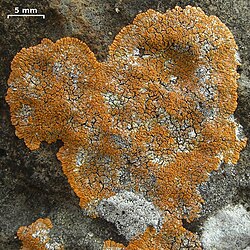Biology:Wetmoreana brouardii
| Wetmoreana brouardii | |
|---|---|

| |
| on basalt, Santa Fe Island, Galápagos | |
| Scientific classification | |
| Domain: | Eukaryota |
| Kingdom: | Fungi |
| Division: | Ascomycota |
| Class: | Lecanoromycetes |
| Order: | Teloschistales |
| Family: | Teloschistaceae |
| Genus: | Wetmoreana |
| Species: | W. brouardii
|
| Binomial name | |
| Wetmoreana brouardii (B.de Lesd.) Wilk & Søchting (2020)
| |
| Synonyms[1] | |
| |
Wetmoreana brouardii is a species of saxicolous (rock-dwelling), crustose lichen in the family Teloschistaceae.[2]
Taxonomy
It was first formally described as a new species in 1914 by French lichenologist Maurice Bouly de Lesdain, who classified it in the genus Placodium. In 1931, Alexander Zahlbruckner transferred it to Caloplaca,[3] and it was known as a member of that genus for almost a century. In the 2000s several molecular phylogenetics studies showed that the large genus Caloplaca was polyphyletic, and several smaller genera were circumscribed to more appropriately reflect phylogenetic relationships in the Teloschistaceae. In 2015, Sergey Kondratyuk and colleagues proposed to move Caloplaca brouardii to the genus Fulgogasparrea. Katrina Wilk and Ulrik Søchting transferred it to the genus Wetmoreana in 2020.[4]
Habitat and distribution
The lichen is widely distributed, having been found in Africa, North America, and South America (including the Galápagos Islands).[4]
References
- ↑ "Synonymy. Current Name: Wetmoreana brouardii (B. de Lesd.) Wilk & Søchting, in Bungartz, Søchting & Arup, Plant and Fungal Systematics 65(2): 562 (2020)". Species Fungorum. https://www.speciesfungorum.org/Names/SynSpecies.asp?RecordID=836904.
- ↑ "Wetmoreana brouardii (B. de Lesd.) Wilk & Søchting". Species 2000: Naturalis, Leiden, the Netherlands. https://www.catalogueoflife.org/data/taxon/B2QHQ.
- ↑ Zahlbruckner, A. (1931) (in la). Catalogus Lichenum Universalis. 7. p. 220.
- ↑ 4.0 4.1 Bungartz, Frank; Søchting, Ulrik; Arup, Ulf (2020). "Teloschistaceae (lichenized Ascomycota) from the Galapagos Islands: a phylogenetic revision based on morphological, anatomical, chemical, and molecular data". Plant and Fungal Systematics 65 (2): 515–576. doi:10.35535/pfsyst-2020-0030. https://www.researchgate.net/publication/348067584.
Wikidata ☰ entry
 |

